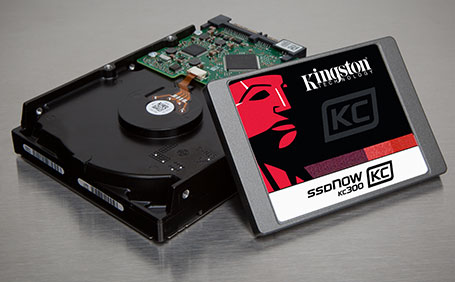

[ Image from Kingston’s website ]
Indeed. One of the added bonuses of having an SSD is elimination of the need to run defragmentation. In the old HDD world, as data is written onto the platters, there isn’t always a continuous disk space available. Thus, data gets split into two (or much more) chunks and written that way. Well, you have your data and can access it. It will show up to you and your apps as a single chunk, not many. And yet, there’s a problem with that. Hard drives need lots of time to position their heads to a specific position to read a specific part of your disk. If your files are fragmented and thus scattered around the hard drive, reading them as a whole is a much slower operation than if they were a continuous whole.
To remedy this issue, Windows has a built-in process called defragmentation. This means reading all those scattered parts of your files, reallocating the disk space and writing them back in a way that each file is fragmented no more. This is a lengthy operation, and is run on a regular basis (usually once a week).
Solid state drives, on the other hand, have no mechanical parts and thus “positioning” is very fast there, meaning there is no need to run defragmentation. On the contrary, as SSDs have limited write cycles, rewriting huge portions of data is harmful to them, shortening their lifespan considerably. Thus, no defragmentation for SSDs. Fragmentation has almost no impact on your SSD’s performance.
But there’s a problem with that.
If you happen to have purchased your brand new SSD and moved your existing Windows installation over from your aging HDD (this can be done with many tools, including almost any Linux live CD; I particularly like Redo Backup as it has all the tools built in – gParted for partition resizing and command line dd for actual cloning), you may notice that under disk properties where the disk defragmenter is launched, it still shows up as a hard drive. This implicates that weekly defragmentation tasks are still being run. And this is bad.
To remedy this issue, open an elevated command prompt (for Windows 7 – click Start, then type cmd, then right click on Command Prompt and choose Run as administrator; for Windows 8.1/10 – right click Start, then choose Command Prompt (Administrator)) and type in this command (pressing Enter after it – this notice is because many Windows users are so unaccustomed to command line):
winsat formal
This will run the Windows performance assessment test and also “reset” your hard drive/SSD type, so from now on Windows will recognize your new SSD as such.
Should you happen to move back to HDD, don’t forget to perform this operation again.
After I applied this command “winsat formal” without quotation, am still seen HDD instead of SSD
Did you do that from the _administrative_ command prompt or from the “normal” one?